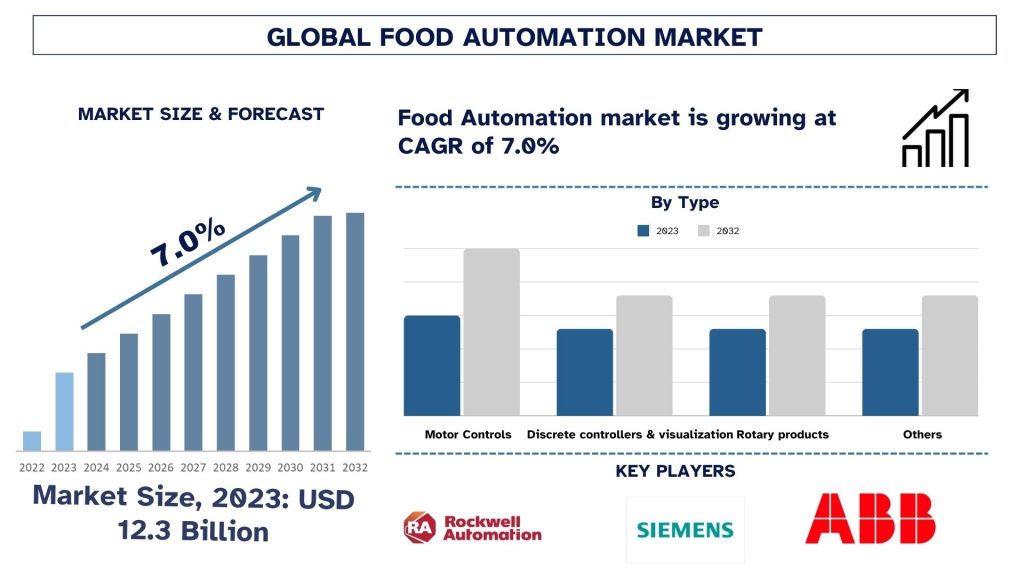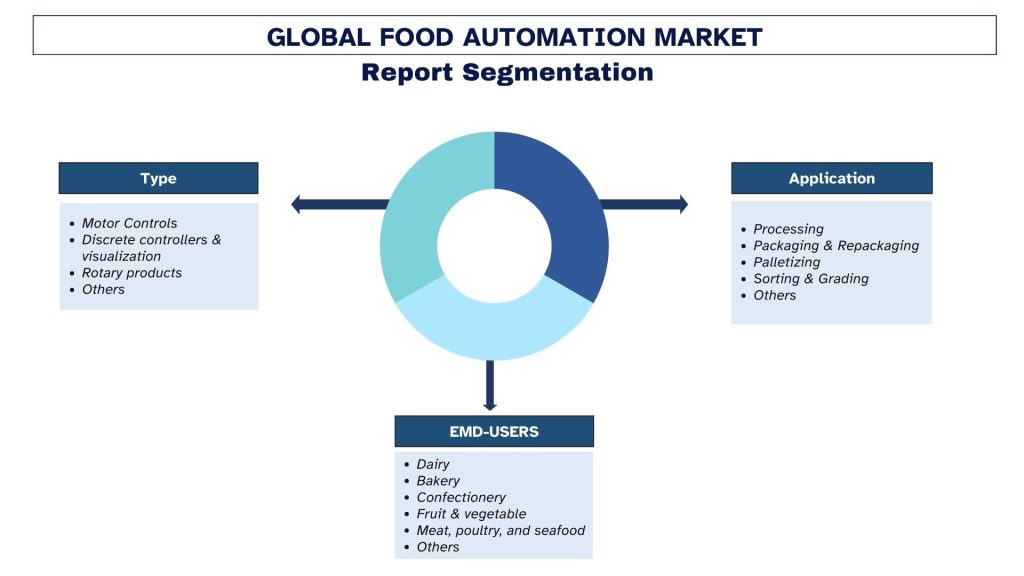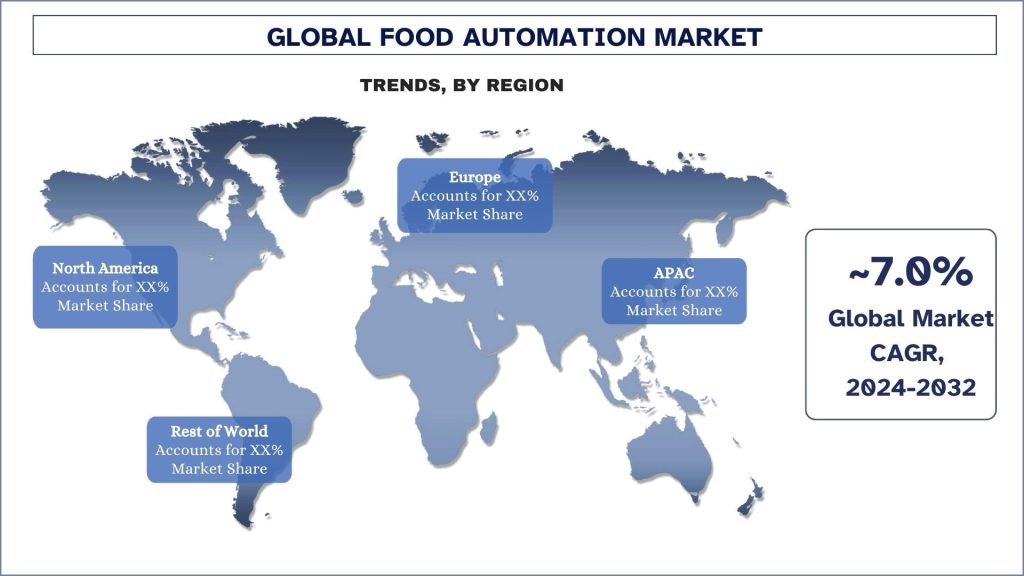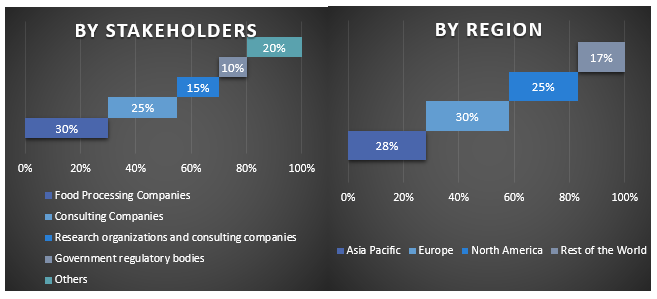Food Automation Market: Current Analysis and Forecast (2024-2032)
$3999 – $6999
Emphasis on Type (Motor Controls, Discrete controllers & visualization, Rotary products, Others); Application (Processing, Packaging & Repackaging, Palletizing, Sorting & Grading, Others); End-User (Dairy, Bakery, Confectionery, Fruits and Beverage, Meat-Poultary & Sea-Food, Others); Region/Country
| Pages: | 252 |
|---|---|
| Table: | 48 |
| Figure: | 142 |
| Report ID: | UMCG21793 |
| Geography: |

Report Description
Food Automation Market Size & Forecast
The Food Automation market was valued at approximately USD 12.3 Billion in 2023 and is expected to grow at a robust CAGR of around 7.0% during the forecast period (2024-2032). The food automation market is on the rise due to efficiency, food safety, the employees’ cost control needs, rising technology, and a need for fast and effective food production procedures.
Food Automation Market Analysis
The food industry is one of the largest manufacturing sectors across the globe. In the United States, it accounts for more than 10% of all shipments. An emerging number of food processing companies across regions leading to the growing market of food automation across the globe. More than 30% of the top 50 food & beverage-processing firms in the world are headquartered in the United States.
According to the latest available Federal data, in 2021, the U.S. food and beverage manufacturing sector employed 1.7 million people or more than 1.1 percent of all U.S. nonfarm employment. Within the U.S. manufacturing sector, food and beverage manufacturing employees accounted for the largest share of employees (15.4 percent). The growing demand for processed and packaged food in the region acts as a growth catalyst for the industry. 80% of Americans’ total calorie consumption comes from store-bought foods and beverages (packaged and unpackaged). Moreover, the rise in work-related fatalities in the region is also proliferating the growth of the demand.
Food Automation Market Trends
This section discusses the key market trends influencing the Food Automation segments as identified by our research experts.
Motor Controls Segment Transforming Industry
Based on the type, the market is fragmented into Motor Controls, Discrete controllers & visualization, Rotary products, and others. The motor control segment captured a considerable share market in 2023. Achieving high demands and dynamic behavior and precision is critical in using industrial automation, where motor control plays a significant role. The usage of motors in motion control has increased significantly because of the growth in handling applications as washing down high pressure and high torque with precision motion control.
Asia Pacific expected to grow in the market
The food automation market in the Asia Pacific market is showing considerable growth and has several reasons. With population congestion in urban areas due to development, there has been pressure to increase yields and food processing companies to feed urban dwellers. Furthermore, multiple countries record increasing labor costs forcing manufacturing companies to implement automated systems to minimize reliance on workplace manpower and improve productivity. The increasing consumers’ emphasis on processed and convenience foods adds more force to the adoption of automation techniques in the food industry since organizations are under pressure to meet consumers’ quality standards while producing foods much faster than before. Integration of artificial intelligence and IOT in food processing is drastically shifting traditional approaches to the modern advanced way of processing. In addition to that, authorities that set and implement policies and measures on food safety and quality are also initiating proper food prices, thus pressuring food businesses into adopting automation technologies to achieve compliance and gain a competitive advantage. All these factors together provide a strong foundation for the growth of the food automation market in the Asia Pacific region.
Food Automation Industry Overview
Food Automation is competitive, with several global and international market players. The key players are adopting different growth strategies to enhance their market presence, such as partnerships, agreements, collaborations, new product launches, geographical expansions, and mergers and acquisitions. Some of the major players operating in the market are Rockwell Automation, Inc., Siemens AG, ABB Ltd, Mitsubishi Electric Corporation, Schneider Electric SE, Yokogawa Electric Corporation, GEA Group, Fortive Corporation, Yaskawa Electric Corporation, Rexnord Corporation, etc. Several M&As along with partnerships have been undertaken by these players to facilitate customers with hi-tech and innovative products/technologies.
Recent Development
On 30 May 2024, ABB Robotics signed a Memorandum of Understanding with Seoul-based food processing company Pulmuone Co Ltd to develop automation solutions in the research and production of a novel range of laboratory-grown foods.
On 4 September 2024, Mitsubishi Electric technologies enabled the development of innovative composting machines that can turn food waste into high-quality fertiliser in just 24 hours. This solution responds to the global problem of waste, in particular food waste, which constitutes about 30% of landfill waste.
Food Automation Market Report Coverage
Reasons to buy this report:
- The study includes market sizing and forecasting analysis validated by authenticated key industry experts.
- The report presents a quick review of overall industry performance at one glance.
- The report covers an in-depth analysis of prominent industry peers with a primary focus on key business financials, product portfolios, expansion strategies, and recent developments.
- Detailed examination of drivers, restraints, key trends, and opportunities prevailing in the industry.
- The study comprehensively covers the market across different segments.
- Deep dive regional level analysis of the industry.
Customization Options:
Global Food Automation can further be customized as per the requirement or any other market segment. Besides this, UMI understands that you may have your own business needs; hence, feel free to connect with us to get a report that completely suits your requirements.
Frequently Asked Questions (FAQ)
Ans: The Global Food Automation market was valued at USD 12.3 Billion in 2023 and is expected to grow at a CAGR of 7% during the forecast period (2024-2032).
Ans: The food automation market is on the rise due to efficiency, food safety, the employees’ cost control needs, rising technology, and a need for fast and effective food production procedures.
Ans: The Motor Control segment has the largest Food Automation share by type.
Ans: Emerging technologies in global food automation include the integration of artificial intelligence, robotics, IoT, and blockchain for enhanced efficiency, quality control, and traceability in food production and supply chains.
Ans: North America dominate the market in 2023. Q1: What is the global Food Automation's current size and growth potential?
Q2: What are the driving factors for the growth of global Food automation?
Q3: Which segment has the largest share of the global Food Automation by type?
Q4: What are the emerging technologies and trends in global Food Automation?
Q5: Which region will dominate global Food Automation?

You can also purchase parts of this report. Do you want to check out a section wise
price list?
Research Methodology
Research Methodology for the Food Automation Market Analysis (2022-2032)
Analyzing the historical market, estimating the current market, and forecasting the future market of the global Food Automation market were the three major steps undertaken to create and analyze the adoption of Food Automation in major regions globally. Exhaustive secondary research was conducted to collect the historical market numbers and estimate the current market size. Secondly, numerous findings and assumptions were taken into consideration to validate these insights. Moreover, exhaustive primary interviews were also conducted, with industry experts across the value chain of the global Food Automation market. Post assumption and validation of market numbers through primary interviews, we employed a top-down/bottom-up approach to forecasting the complete market size. Thereafter, market breakdown and data triangulation methods were adopted to estimate and analyze the market size of segments and sub-segments of the industry. Detailed methodology is explained below:
Analysis of Historical Market Size
Step 1: In-Depth Study of Secondary Sources:
A detailed secondary study was conducted to obtain the historical market size of the Food Automation market through company internal sources such as annual reports & financial statements, performance presentations, press releases, etc., and external sources including journals, news & articles, government publications, competitor publications, sector reports, third-party database, and other credible publications.
Step 2: Market Segmentation:
After obtaining the historical market size of Food Automation, we conducted a detailed secondary analysis to gather historical market insights and share for different segments & sub-segments for major regions. Major segments are included in the report, such as type, application, end-users, and region. Further country-level analyses were conducted to evaluate the overall adoption of testing models in that region.
Step 3: Factor Analysis:
After acquiring the historical market size of different segments and sub-segments, we conducted a detailed factor analysis to estimate the current market size of the Food Automation market. Further, we conducted factor analysis using dependent and independent variables such as type, application, end-users, and Food Automation regions. A thorough analysis was conducted of demand and supply-side scenarios considering top partnerships, mergers and acquisitions, business expansion, and product launches in the Food Automation market sector across the globe.
Current Market Size Estimate & Forecast
Current Market Sizing: Based on actionable insights from the above three steps, we arrived at the current market size, key players in the global Food Automation market, and market shares of the segments. All the required percentage shares split and market breakdowns were determined using the above-mentioned secondary approach and were verified through primary interviews.
Estimation & Forecasting: For market estimation and forecast, weights were assigned to different factors including drivers & trends, restraints, and opportunities available for the stakeholders. After analyzing these factors, relevant forecasting techniques i.e., the top-down/bottom-up approach were applied to arrive at the market forecast for 2032 for different segments and sub-segments across the major markets globally. The research methodology adopted to estimate the market size encompasses:
The industry’s market size, in terms of revenue (USD) and the adoption rate of Food Automation across the major markets domestically
All percentage shares, splits, and breakdowns of market segments and sub-segments
Key players in the global Food Automation in terms of products offered. Also, the growth strategies adopted by these players to compete in the fast-growing market
Market Size and Share Validation
Primary Research: In-depth interviews were conducted with the Key Opinion Leaders (KOLs), including Top Level Executives (CXO/VPs, Sales Head, Marketing Head, Operational Head, Regional Head, Country Head, etc.) across major regions. Primary research findings were then summarized, and statistical analysis was performed to prove the stated hypothesis. Inputs from primary research were consolidated with secondary findings, hence turning information into actionable insights.
Split of Primary Participants in Different Regions
Market Engineering
The data triangulation technique was employed to complete the overall market estimation and to arrive at precise statistical numbers for each segment and sub-segment of the global Food Automation. Data was split into several segments and sub-segments after studying various parameters and trends in the type, application, end-users, and regions of the global Food Automation market.
The main objective of the Global Food Automation Market Study
The current & future market trends of global Food Automation were pinpointed in the study. Investors can gain strategic insights to base their discretion for investments on the qualitative and quantitative analysis performed in the study. Current and future market trends determined the overall attractiveness of the market at a regional level, providing a platform for the industrial participant to exploit the untapped market to benefit from a first-mover advantage. Other quantitative goals of the studies include:
- Analyze the current and forecast market size of the Food Automation market in terms of value (USD). Also, analyze the current and forecast market size of different segments and sub-segments.
- Segments in the study include areas of type, application, end-users, and regions.
- Define and analyze the regulatory framework for the Food Automation
- Analyze the value chain involved with the presence of various intermediaries, along with analyzing customer and competitor behaviors of the industry.
- Analyze the current and forecast market size of the Food Automation market for the major regions.
- Major countries of regions studied in the report include Asia Pacific, Europe, North America, and the Rest of the World
- Company profiles of the Food Automation market and the growth strategies adopted by the market players to sustain in the fast-growing market.
- Deep dive regional level analysis of the industry







